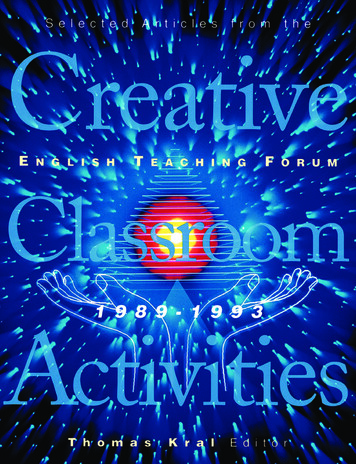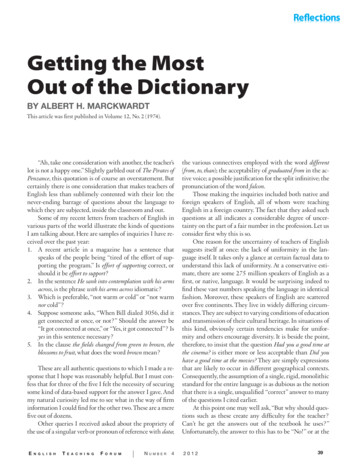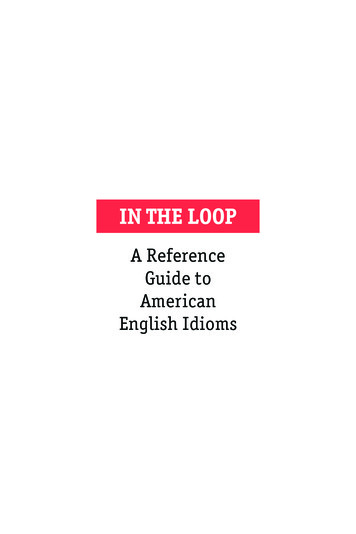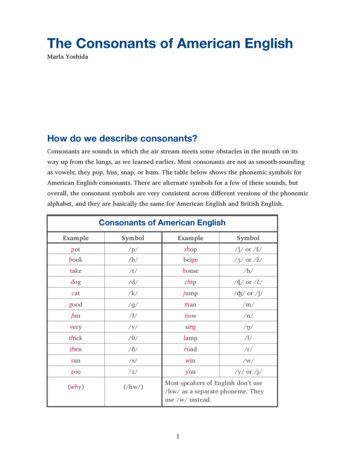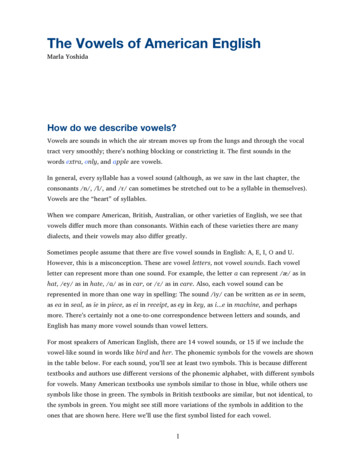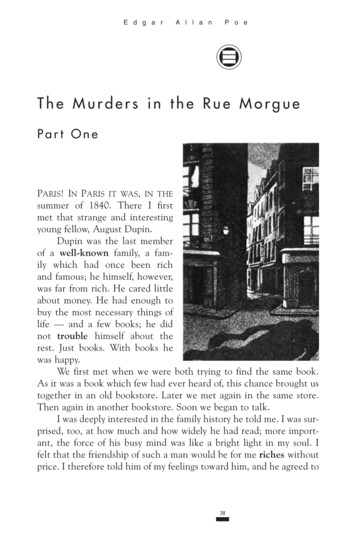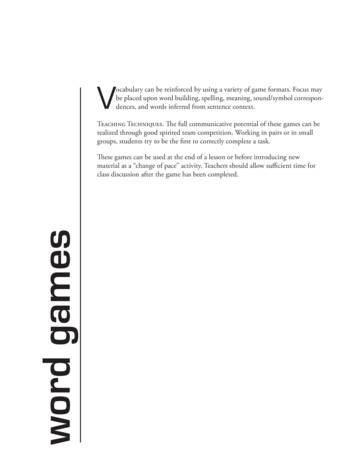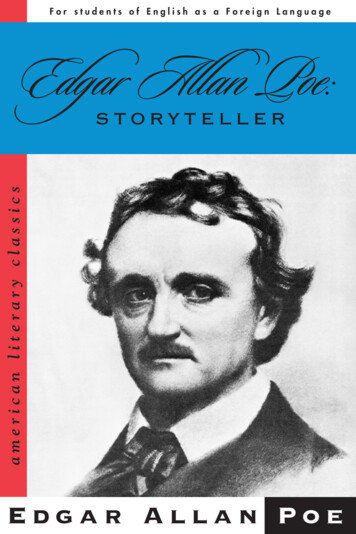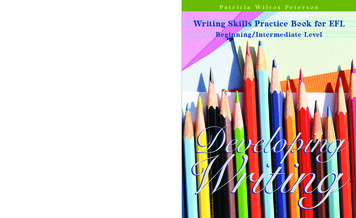
Transcription
Patr ic ia Wilcox Peter sonDeveloping Writing: WRITING SKILLS PRACTIEDeveloping WritingWriting Skills Practice Book for EFLPAT R I C I A W I L C OX P E T E R S O NEach of the twenty chapters in Developing Writing is introducedby a topical reading selection incorporating the lesson’s modelstructures, mechanics, and grammar points. Following eachreading are activities designed for students to study composi tion, vocabulary, and spelling. The goal of this book is to takethe student from the mechanics of basic sentence writing to theability to construct a simple paragraph. Appendices include anirregular verb list, grammar rule index, and answer keys.BOOK FORUNITED STATES DEPARTMENTOFSTATEOffice of English Language ProgramsPETERSON4155EFL Writing Skills Practice Book for EFLBeginning/Intermediate LevelDevelopingWriting
DevelopingWritingWriting Skills Practice Book for EFLBeginning/Intermediate LevelPatr ic ia Wilcox Peter sonUNITED STATES DEPARTMENTOFSTATEOffice of English Language Programs
Developing WritingWriting Skills Practice Book for EFLPatricia Wilcox PetersonOriginally published in 1982,Materials Development and Review BranchThe English Language Programs DivisionUnited States Information AgencyWashington, DCSecond printing published in 1995This reprint published in 2003.Office of English Language ProgramsUnited States Department of StateWashington, DCThe author wishes to thank Gloria Kreisher and Dean Curry for their help, as well as book editor Lin Lougheed.She also wishes to thank Luis Roja of Caracas, for his knowledge of Venezuela and his help in providing authentic details of life there.Office of English Language ProgramsBureau of Educational and Cultural AffairsUnited States Department of StateWashington, DC ing/
TABLE OF CONTENTSIntroduction.ixChapter 1:“Square Dancing” .1I. Mechanics: Capital letters at the beginning of sentencesand for names. Periods at the end of sentences.II. Grammar: Subject pronouns .III. Grammar: Conjugation of be in the present .IV. Controlled Composition: Dicto-comp .V. Sentence Construction: Sentence patterns with be.VI. Sentence Construction: Concentration .VII. Controlled Composition: Changing from first personto third person pronouns and verbs.VIII. Vocabulary and Spelling: Puzzle .Chapter 2:“The Weekend Cook” .I. Mechanics: Capital letters for nationalities and forthe days of the week .II. Grammar: Third person -s forms in the present tense .III. Grammar: Subject-verb agreement .IV. Grammar: Object pronouns .V. Sentence Construction: Sentence patterns with presenttense verbs .VI. Grammar: Adverbs of frequency with be and othermain verbs .VII. Grammar: Adverbs of time at the beginning of the sentence .VIII. Controlled Composition: Responding to questions .IX. Free Composition.Chapter 414“That’s Not My Job” .15Grammar: Contractions with pronouns and be, be and not.Grammar: Spelling noun plurals .Grammar: Possessive’s with people .Mechanics: Review of capitalization and punctuation .Grammar: Choosing a or an .Controlled Composition: Dicto-comp .Grammar: Subject-verb agreement .Sentence Construction: Sentence patterns with presenttense verbs .1616161717181818
Chapter 4:“In a Restaurant” .20Mechanics: Review of capitalization and punctuation .Grammar: Noun plurals .Grammar: Subject-verb agreement .Grammar: Articles .Controlled Composition: Dicto-comp .Sentence Construction: Concentration .Sentence Construction: Sentence patterns with presenttense verbs .VIII. Vocabulary and Spelling: Puzzle .212121222222I.II.III.IV.V.VI.VII.Chapter 5:2324“Pen Pals: Roberto Writes a Letter” .25I. Mechanics: A. Noun pluralsB. Capital letters for the names of streets,cities, states, and countries. Commas andquestion marks .II. Grammar: Possessive adjectives.III. Controlled Composition: Replacement exercise .IV. Grammar: Prepositions of place: in, on, at .V. Grammar: Questions with be .VI. Grammar: Questions with do .VII. Sentence Construction: Asking and answering questions.VIII. Controlled Composition: Incomplete letter.2626272828293030Chapter 6:“Pen Pals: Sara Writes Back”.31I. Mechanics: A. Noun pluralsB. The exclamation point .II. Grammar: Making negative statements with don’t and doesn’t .III. Mechanics: Review of capitalization and punctuation .IV. Sentence Construction: Making questions about topics .V. Sentence Construction: Concentration .VI. Controlled Composition: Incomplete dialog .VII. Grammar: Articles .VIII. Controlled Composition: Dicto-comp .3232333334343535Chapter 7:“Enormous Cabbages Show the Effect ofLong Alaskan Days” .36I. Mechanics: Capital letters for the names of continents, oceans,rivers, mountains, valleys, and the months of the year . 37II. Grammar: The definite article the before proper names . 37
III. Grammar: Sentence combining with and, or, but, and so .IV. Sentence Construction: Concentration .V. Sentence Construction: Expanding sentenceswith adjectives .VI. Controlled Composition: Incomplete letter.VII. Controlled Composition: Incomplete dialog .VIII. Vocabulary and Spelling: An Alaskan crossword puzzle.Chapter 8:I.II.III.IV.V.VI.VII.VIII.40414243“Food Customs” .44Mechanics: Capitalization and punctuation .Grammar: Sentence combining with the main verb deleted .Grammar: Subject-verb agreement .Sentence Construction: Noncount nouns .Grammar: Articles .Controlled Composition: Dicto-comp .Controlled Composition: Writing about your food habits .Vocabulary and Spelling: Word puzzle .4546474748484849Chapter 9:“The Kramers’ Woodpile” .I. Mechanics: A. Third person -s formsB. Review of capitalization and punctuation.II. Grammar: Review of the rules for articles withcommon nouns .III. Grammar: Using the definite article the for secondmention of nouns .IV. Controlled Composition: Dicto-comp .V. Grammar: Subject-verb agreement .VI. Controlled Composition: Responding to a picture .VII. Sentence Construction: Words that are both nouns and verbs .VIII. Vocabulary and Spelling: Compound nouns .Chapter 10: “In the City or in the Suburbs?” .I.II.III.IV.V.VI.VII.VIII.3939Grammar: Count and noncount nouns with articles .Controlled Composition: Dicto-comp .Sentence Construction: Statements with There is and There are .Sentence Construction: Questions with Is there and Are there .Grammar: Word order with adverb phrases .Grammar: Sentence combining review .Controlled Composition: Incomplete letter.Vocabulary and Spelling: Compound nouns .505151525253535454555656565859596061
Chapter 11: “Riddles” .I.II.III.IV.V.VI.VII.VIII.62Grammar: Review of verbs in yes-no questions .Grammar: Information questions .Sentence Construction: Concentration .Grammar: Possessives with things .Sentence Construction: Writing riddles .Grammar: Choosing prepositions .Controlled Composition: Choosing relevant information .Vocabulary and Spelling: Puns .6363646566676768Chapter 12: “Crowding” .70I.II.III.IV.V.VI.VII.VIII.Mechanics: Using commas in a series .Grammar: Spelling -ing verb forms .Grammar: Subject-verb agreement .Controlled Composition: Dicto-comp .Grammar: The definite article the before prepositional phrasesSentence Construction: Making questions about topics .Controlled Composition: Incomplete dialog .Controlled Composition: Choosing relevant information .7171727273737475Chapter 13: “Corner Stores and Supermarkets”.77I. Mechanics: A. Spelling of -ing formsB. Capital letters for the names ofcompanies and stores .II. Grammar: Comparison of adjectives .III. Sentence Construction: Making comparisons .IV. Controlled Composition: Choosing relevant information .V. Controlled Composition: Dicto-comp .VI. Grammar: The definite article the with specific groups .VII. Controlled Composition: Variety in sentence types .VIII. Vocabulary and Spelling: Crossword puzzle .7878808181828283Chapter 14: “Family Roles” .84I. Mechanics: A. Noun pluralsB. The colon before a list of examples.II. Grammar: The past tense of to be .III. Grammar: The past tense with regular verbs .IV. Controlled Composition: Dicto-comp .V. Sentence Construction: Comparisons with more, less,and fewer .8585868787
VI. Grammar: Sentence combining: compound sentence parts.VII. Controlled Composition: Variety in sentence types .VIII. Controlled Composition: Choosing relevant information .888990Chapter 15: “Tall Tales” .91I. Mechanics: A. Review of comparisons .B. Quotation marks.II. Grammar: Past tense irregular verbs.III. Controlled Composition: Dicto-comp .IV. Sentence Construction: Questions and negatives with did .V. Grammar: Using very, too, enough, so that,and such that.VI. Controlled Composition: Organizing ideas .VII. Controlled Composition: Responding to a picture .VIII. Controlled Composition: Responding to a picture .939394949495969798Chapter 16: “Making a Banana Split” .99I. Mechanics: A. Regular and irregular past tense verbsB. Using a comma after a subordinate clause .II. Grammar: The past progressive tense .III. Controlled Composition: Past narration .IV. Grammar: Sentence combining with adverb clauses .V. Grammar: Review of articles, some as a quantifier.VI. Controlled Composition: Dicto-comp .VII. Controlled Composition: Organizing ideas .VIII. Controlled Composition: Past narration .IX. Free Composition.101101102102103103104104104Chapter 17: “A Debate: Dogs in the City” . 105I. Mechanics: A. Review of comparisonsB. The semi-colon in sentence combining .II. Grammar: Sentence combining with subordinateconjunctions and conjunctive adverbs .III. Sentence Construction: Concentration .IV. Grammar: Modal auxiliaries .V. Controlled Composition: Dicto-comp .VI. Controlled Composition: Variety in sentence types .VII. Controlled Composition: Incomplete dialog .VIII. Free Composition.106107108109110110111112
Chapter 18: “Planning a Trip” . 114I.II.III.IV.V.VI.VII.VIII.Mechanics: Contractions with have and will .Sentence Construction: The present perfect tense .Controlled Composition: Incomplete dialog .Controlled Composition: Dicto-comp .Grammar: Indefinite pronouns: some, any, and one .Grammar: Sentence combining practice .Sentence Construction: Writing complete sentences .Vocabulary and Spelling: Past participles as adjectives .115115117117118118119120Chapter 19: “Phobias” . 122I.II.III.IV.V.VI.VII.VIII.Mechanics: Nonrestrictive relative clauses .Grammar: Restrictive relative clauses .Grammar: Subject-verb agreement .Controlled Composition: Dicto-comp .Sentence Construction: Writing definitions .Grammar: Substituting that for which or who .Controlled Composition: Organizing ideas .Vocabulary and Spelling: Present participles asadjectives .123123124125125125126127Chapter 20: “A Day at the Beach”. 128I.II.III.IV.V.Mechanics: Quotations and paragraphs .Grammar: Final review of articles .Controlled Composition: Dicto-comp .Grammar: Reduced relative clauses .Sentence Construction: Indefinite pronouns:one, ones, and kind .VI. Grammar: Choosing prepositions .VII. Controlled Composition: Variety in sentence types .VIII. Vocabulary and Spelling: Crossword puzzle ofirregular verbs .Appendix A:Appendix B:Appendix C:129129130130131132133133Common Irregular Verbs. 135Review of Grammar. 138Answers to Puzzles . 141
INTRODUCTION TO THE TEACHERThe goal of this book is to take the student from the mechanics of ba sic sentence writing to the ability to construct a simple paragraph. Thevocabulary and the structures have been planned chapter by chapter,from simple to more complex, and the lessons build on each other. Forthis reason, the students will probably benefit the most if they do theexercises in each chapter in the order they are presented. The same istrue of the order of the chapters: information presented early in thebook will be helpful for the writing tasks in the later chapters.The amount of time needed to work through a chapter depends onthe level of the students, the length of the class period, and theteacher’s decision about homework. Some groups may finish a chapterin two hours, with two hours of outside work. Other groups may do allthe exercises in class in four or five hours. Two sample lesson plans aresuggested at the end of this section, one with homework assignmentsand one without homework.Each chapter includes some of the following exercises:1. Text The text is a reading selection that contains the model struc tures upon which the chapter is based. There is a variety of styles andregisters of English. Some of the texts are descriptions; some are nar ratives; some are newspaper articles; some are dialogs; and some areletters.The teacher may read the text out loud, or he may ask the students toread it silently. The texts in dialog form (chapters 3,10 and 20) aresuitable for dramatic reading in pairs. After the first reading, the teachermay want to clarify new vocabulary words and ask a few comprehen sion questions.2. Mechanics This section helps to reinforce the new vocabulary,ideas, and structures in the text. To present the section, the teachershould explain the rule of punctuation or capitalization to the class, andwrite the example or the first problem on the board. Then the studentscan do the remaining problems.One effective method for checking the students’ work is to divide thechalkboard into sections and ask each student to write one answer in asection. Several students can do this at once, to save class time. Thenthe class as a whole can read and correct the boardwork. This self ix
correction builds awareness of the mechanical rules of English andshould encourage careful writing.3. "r mm r Many types of structures are included under this head ing. Essentially everything that is rule based is included here: questiontransformations, negation, tenses, and sentence combining. One par ticularly important goal of the book is to give practice in the use of arti cles. Rules for article use are introduced very gradually and drilledrepeatedly. An index to grammatical information is given in the appendi ces in the back of the book.The teacher will want to discuss the rule briefly before the studentsdo an exercise, and the class should do one or two problems togetherso the teacher is sure that they understand. Many grammar exercisescan be done orally first, and this strengthens the students’ listening andspeaking skills. Oral work is appropriate for sentence combining, wordorder exercises, question transformations, negations, and tense work.It may be especially useful to read the article exercises aloud, to helpthe students develop a sense of correctness with English articles. Whenthe students write out the problems, they may work individually or inpairs. Work should always be collected, corrected, and returned for thestudents to see.4. #entence !onstruction Exercises under this heading introduceelements of free choice in writing. The students are given some sen tence parts, but they must put the sentence together in their own way.Often there is more than one correct response to each problem.These exercises may be done in class or as homework. Since theseexercises involve the beginning of some original thought, students oftenlike to see each other’s work. Sentences can be written on the board,corrected, and discussed. The incomplete dialogs in chapters 3, 6, 7,12, and 17 should provide enjoyment if the students read them aloud inpairs. One type of sentence construction exercise, the game ofConcentration, must be done in class with a partner.5. !ontrolled !omposition The purpose of these exercises is to givepractice in writing student generated short paragraphs, letters, dialogs,and other units longer than a single sentence. Some of the exercisesare suitable for homework, and some can be best done in class.Another way to handle these compositions is to hold a writing lab with in the classroom. In this procedure, each student works independently;the teacher walks around the room, commenting on the papers andx
helping students one by one. Especially good compositions can beread aloud at the end of the lab period.A few composition exercises are of the highly controlled variety, inwhich the students’ task is basically to copy a given text and to makecertain required changes of tense, pronoun usage, or similar changes.These occur primarily in the first half of the book, when the students’grammatical repertoire is still fairly limited.Dicto-comps are used in almost every chapter to form a bridge between grammar work and free writing. They resemble dictations in thatthe content has been predetermined. However, as the directions indicate, the students are not asked to write a word-for-word copy of theoriginal. Rather, they are to listen three times before writing, and then tocompose a paragraph from memory, as close to the wording of theoriginal as possible.Partly completed compositions with large blanks are a kind of controlled composition that calls for more student input. These assignments provide the students with choices that are varied enough to allowan opportunity for expression, but controlled enough to make incorrectcombinations rather unlikely. By completing each sentence appropriately, students can practice writing paragraphs, letters, and memos intheir own words, conforming to a standard form.Some composition assignments are almost entirely free, stimulatedby a list of questions or a picture. When this kind of assignment is given,there has been a previous text in the chapter which can serve as amodel.In the second half of the book there are exercises that treat the process of composition as a problem of arranging and ordering ideas. Inthese assignments, sentences are given to the students, but they areout of order. The students’ task is to rewrite the composition in a logical order.6. Vocabulary and Spelling Often the final section of a chapter is agame activity. There are puzzles and word games to expand studentvocabulary and to focus attention on accurate spelling. In this section,as well as in the grammar section, attention is given to the spelling andusage of inflectional and derivational affixes. These sections are intended to bring some fun to the drudgery of spelling work. They shouldbe done in class in pairs or even in teams. At the end of a unit, theteacher may want to reward the class by arranging a competitive game,in which two teams try to be the first to complete a puzzle.xi
Below are two possible time schedules for a typical chapter in thebook.Two-Hour Plan withHomeworkFour-Hour Plan with noHomeworkDay oneText Read the text aloud or silently, clarify vocabulary, andask comprehension questions.Mechanics Explain the rule,have students write thesentences on the board, andcorrect their work.Grammar Review the rule anddo some problems orally.Students write out the exerciseindividually or in pairs. Collectthe papers.Homework Sentence Construction ExerciseDay OneText Read the text aloud or silently, clarify vocabulary, andask comprehension questions.Mechanics Explain the rule,have students write thesentences on the board, andcorrect their work.Grammar Review the rule anddo some problems orally.Students write out the exercise individually or in pairs.Collect the papers.Day TwoSentence ConstructionexerciseHave students act out dialogs,compare different studentanswers, or do Concentrationgame in class.Dicto-CompDay TwoCorrect the Sentence Construction exercise in class andcompare answers.Dicto-CompPuzzle Students work in pairsor in teams.Homework Controlled CompositionDay ThreeControlled CompositionUse the writing lab technique.The students may do one ormore compositions, as timepermits.Day FourDiscuss the student compositions and compare them. Havestudents read each other’swork to develop a critical eye.Puzzle Team gamexii
" !PT#R ON#SQU!RE D!NCINGHello. I am Ernie Anderson. Iam a truck driver. I am from theUnited States.Here is a picture of my wife andme. We are with our friends. Weare square dancers. Dancing isnot our work. It is our hobby.The square dance is an old American dance for four couples. A cou ple is one man and one woman. Three other couples are in our square.Their names are Bob and Marsha, Doug and Cathy, and Henry andEileen.My wife’s name is Hazel. Her dress is short and full. It is a square dance dress. We are in the front on the left. The music is very fast rightnow.1
I. Mechanics Capital letters at the beginning of sentences and fornames. Periods at the end of sentences.Each new sentence begins with a capital letter and ends with aperiod (.)This is a good sentence, this is not correctNames begin with capital letters, too:Ernie Anderson Bob and Marsha KovacikCopy the sentences, and make all the corrections that are necessary.1.2.3.4.5.6.7.8.9.10.i am ernie andersoni am from the united stateswe are square dancersdancing is our hobbyit is an american dancebob and marsha are our friendshenry and eileen are another couplea couple is a man and a womanhazel is my wifewe are in the front of the pictureII. GrammarSubject pronounsStudy the pronouns below. Then rewrite each sentence and substitute the appropriate pronoun for each name.I(the speaker)we(the speaker and others)you (the second person)you(plural)he (masculine)they (plural for men, women,things, or animals)she (feminine)it(things and animals)2
ErnieBobDougHenryEileen1. Bob is a dancer.7.He is a dancer.8.2. Ernie is a truck driver.9.3. Doug is from America.10.4. Doug, Ernie, and Bob are friends. 11.5. Hazel and Eileen are friends.12.6. Cathy and Marsha are in the picture.CathyMarsha HazelHazel is Ernie’s wife.Hazel is a square dancer.Dancing is not work.The music is very fast.The dresses are short and full.The picture is from last year.III. Grammar The verb to beStudy the forms for the verb to be. Then copy the paragraph below,writing in the correct form.l amwe areyou areyou areheshe isthey areitSquare dancing fun. The music fast, and the peoplefriendly. Ernie at the dance every week. Hazel with him.She a good dancer. Six friends with them in a square.They happy to be there.3
IV. Controlled Composition Dicto-compYour teacher will read the paragraph above three times. Listen care fully, but do not take notes. After the third reading, write the paragraphas well as you can from memory.V. Sentence Construction Sentence patterns with beThe verb to be connects the subject of a sentence to another word thattells us something about the subject. This second word or phrase after theverb may be another noun, an adjective, or an adverb. In this way, wecan see three different basic sentence patterns with the verb to be.1. Sentence patterns with noun phrases. The word or phrase after the verb may tell us what or who the subject is:The square dance is an old American dance.Noun phrase be Noun phraseOn the left is a list of subjects. On the right is a list of noun phrases,telling what or who. Choose a subject and a verb and match them witha noun phrase on the right to make a sentence. Write as many sentences as you can. Example: Ernie is a truck driver.Noun phrase ErnieHazelTheyBob and MarshaDancingDoug and Cathybeisare Noun phrasea truck driverhis wifesquare dancersErnie’s friendsfunnot worka hobbyanother couple2. Sentence patterns with adjectives The word or phrase afterthe verb may tell us how t
Writing Skills Practice Book for EFL . structures, mechanics, and grammar points. . Office of English Language Programs . Developing. Writing. Writing Skills Practice Book for EFL . Beginnin

